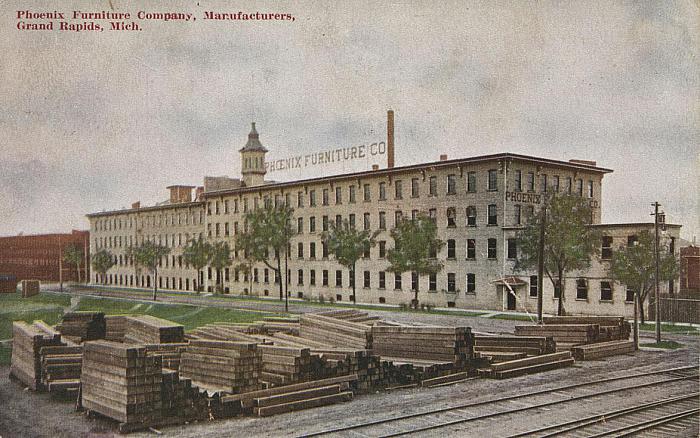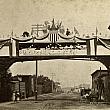Phoenix Furniture Co.
1872 - 1953
Grand Rapids, Michigan
SEE ALSO William A. Berkey Furniture Co.
COMPANY HISTORY
1868: William A. Berkey becomes assignee for the property of cabinetmakers Atkins and Soule.
1872: Berkey combines residuals of Atkins & Soule with $200,000 new capital to form Phoenix Furniture Co.
1873 and 1875: Phoenix opens south, then north portions of its new four-story brick “model” factory at West Fulton and Summer Streets.
1876: Wareroom opens in New York City.
1883: Phoenix more than doubles its production space with construction of a large addition.
1911: Phoenix acquired by Robert W. Irwin, Alexander Hompe, and Ralph Tietsort.
1919: Robert W. Irwin buys out Hompe and Tietsort and consolidates Phoenix and Royal Furniture Companies into the Robert W. Irwin Co. Phoenix products continue to be labeled with the Phoenix name.
1926: Expansions are added to the north and west of the existing plant.
1953: Robert W. Irwin Co. closes; manufacturing complex is occupied for storage temporarily.
Late 1950s: Complex becomes home to Stow & Davis, Inc.
1987: Manufacturing complex donated to Grand Valley State University by Steelcase and Stow & Davis.
1988: GVSU razes Phoenix factory complex; Grand Rapids Public Museum salvages a 2000-square-foot section of the 1873 building.
1994: Factory section is reconstructed in the Van Andel Museum Center of The Grand Rapids Public Museum.
PERSONNEL
The Phoenix Furniture Co. “rose from the ashes” of the Atkins & Soule partnership, with the help of its first president William A. Berkey, and a large investment of new capital. Berkey ran the company until 1879, when controlling interest was sold to J.W. Converse, a capitalist from Boston. Converse employed his friend and in-law from Massachusetts, Robert W. Merrill, to help manage the plant, which he did until 1912. In 1911 ownership of the company changed again, to Robert W. Irwin, who in 1919 consolidated Phoenix and the Royal Furniture Co. into the Robert W. Irwin Co. Because of the prominent reputation of Phoenix, pieces made in its plants were advertised and labeled as “Phoenix Furniture, by the Robert W. Irwin Co.”
 Born and trained as a furniture designer in Rochester, New York, David Wolcott Kendall first made his mark as a designer for the Wooton Desk Co. in Indiana. In 1879 John Strahan, superintendent and designer for the Phoenix factory, hired Kendall from an architecture firm in Chicago to work as a draftsman at Phoenix. But his talents were soon recognized and he was allowed to execute his own designs for the company. He left Phoenix for Berkey & Gay between 1883 and 1886, and formed the short-lived company of Kendall, Beardsley & Dey in Detroit in 1886. During this time Asa Lyon produced designs for Phoenix. Kendall returned to Phoenix as chief designer in 1888. At the time of his death in 1910, Kendall was not only chief designer, but also an officer of the company and general manager of the factory.
Born and trained as a furniture designer in Rochester, New York, David Wolcott Kendall first made his mark as a designer for the Wooton Desk Co. in Indiana. In 1879 John Strahan, superintendent and designer for the Phoenix factory, hired Kendall from an architecture firm in Chicago to work as a draftsman at Phoenix. But his talents were soon recognized and he was allowed to execute his own designs for the company. He left Phoenix for Berkey & Gay between 1883 and 1886, and formed the short-lived company of Kendall, Beardsley & Dey in Detroit in 1886. During this time Asa Lyon produced designs for Phoenix. Kendall returned to Phoenix as chief designer in 1888. At the time of his death in 1910, Kendall was not only chief designer, but also an officer of the company and general manager of the factory.
Kendall traveled extensively throughout the Americas, Europe, and Asia, to collect artifacts and books as inspirations for his own designs. Kendall outfitted an entire chemistry laboratory at the Phoenix factory, in which he experimented with new finish colors for oak. In 1928 Kendall’s widow founded the Kendall Memorial School of Art, now Kendall College of Art and Design, with funds from his estate.
J. Stuart Clingman designed special order furniture for the Tobey Furniture Co. in Chicago before becoming Royal Furniture’s assistant designer under chief designer Alexander Hompe in 1903. Clingman made his mark in the modernization of forms by Hepplewhite and Sheraton. He remained with Robert W. Irwin Co. as designer and officer after the company’s consolidation.
In 1917 William Millington became a designer for Phoenix. Millington was a native of England, and received his training from the Royal College of Arts. Like many of Grand Rapids’ top designers of that period, Millington worked at Waring & Gillow in Lancaster and W. & J. Sloane in New York before coming to Grand Rapids.
PRODUCTS
An 1873 article in the Grand Rapids Daily Eagle described Phoenix’s stock of furniture as “walnut and ash bedroom suits; parlor and divan suits; folding and reclining chairs; marble and wood top center tables; sideboards; pier and looking glasses; couches covered in terry and Brussels carpet; hair, cotton, wool, palm leaf, husk, and excelsior mattresses . . . and office desks, tables and chairs.” Phoenix was the only one of the “big three” Grand Rapids manufacturers (the other two were Nelson, Matter and Berkey & Gay) in the 1870s to manufacture and upholster its own parlor furniture. Much of the company’s 1870s production was probably shipped “in the white” (unfinished), to be finished by the retailer upon arrival.
In the 1880s the firm’s products were listed as the finest grades of chamber suites, folding bedsteads, chiffoniers, ladies’ desks, bookcases, .jpg) sideboards, dining tables, hall stands, and every kind of furniture in mahogany, walnut, ash, oak, maple and cherry. David Kendall’s designs in the mid-1880s included pieces that combined shallow stylized sunflower carving, reminiscent of Eastlake, with busy jig-sawed architectural elements of late Victorian architecture. Phoenix began making “ebonized” furniture in the early 1880s, and produced substantial amounts until its popularity waned in the 1890s.
sideboards, dining tables, hall stands, and every kind of furniture in mahogany, walnut, ash, oak, maple and cherry. David Kendall’s designs in the mid-1880s included pieces that combined shallow stylized sunflower carving, reminiscent of Eastlake, with busy jig-sawed architectural elements of late Victorian architecture. Phoenix began making “ebonized” furniture in the early 1880s, and produced substantial amounts until its popularity waned in the 1890s.
Phoenix opened its special order department in 1884, to produce furniture on contract for hotels, offices, city halls, statehouses, and federal building. Grand Rapids’ elegant city hall opened in 1889, with furniture designed by Kendall and manufactured by Phoenix.
Catalogs from the mid-1890s show a whole series of hexagonal tabourets with concave and convex sides, and Moorish cutouts and stenciling. Many of Kendall’s designs incorporated exotic decoration, with Celtic, Byzantine, Japanese, Moorish, and Arabic origins. Though factory-produced for a mass market, some rested on the cutting edge of fantasy, and were contemporary with such avant garde designers as Carlos Bugatti and Charles Rohlfs.
Phoenix furniture from the 1890s through the first part of the 20th century also bears the innovative finishes developed by Kendall and widely copied by manufacturers and craftsmen across the country. One colorful tale relates that Kendall developed his “antique oak” stain after noticing how tobacco juice spit onto oak floorboards in the factory brought out the wood grain and gave it a pleasing darkened tone. Some of his other fumed and stained finishes transformed oak into hues of green (malachite), grey-black (Flemish), tan (Cremona), and canary yellow. It has even been suggested by a number of sources that Kendall’s finishes were responsible for popularizing oak as a cabinetmaking wood, at a time when oak was readily available and other hardwoods were becoming cost-prohibitive.
 Phoenix’s most successful line was undoubtedly its oak and cane McKinley Chairs, designed by Kendall in 1894. The chairs were so named because one was owned and used by President McKinley. Though the arm and seat rails incorporated delicately exotic Moorish arches, the use of oak, square spindles, and broad armrests, and absence of carved decoration have caused many researchers to anoint the McKinley chair as one of the first examples of the American Mission style. In his The City Built on Wood, historian Frank Ransom states that “the design for the McKinley Chair was supposedly achieved by having persons of varying size sit in snow banks, then transferring the curves left by the impression of the bodies onto the drawing board.” Within a few years of its introduction, other manufacturers in Grand Rapids and elsewhere introduced their own versions of the McKinley chair, causing Kendall to patent the design in 1897. It remained in production into the early 1910s.
Phoenix’s most successful line was undoubtedly its oak and cane McKinley Chairs, designed by Kendall in 1894. The chairs were so named because one was owned and used by President McKinley. Though the arm and seat rails incorporated delicately exotic Moorish arches, the use of oak, square spindles, and broad armrests, and absence of carved decoration have caused many researchers to anoint the McKinley chair as one of the first examples of the American Mission style. In his The City Built on Wood, historian Frank Ransom states that “the design for the McKinley Chair was supposedly achieved by having persons of varying size sit in snow banks, then transferring the curves left by the impression of the bodies onto the drawing board.” Within a few years of its introduction, other manufacturers in Grand Rapids and elsewhere introduced their own versions of the McKinley chair, causing Kendall to patent the design in 1897. It remained in production into the early 1910s.
Some of Kendall’s first designs for Phoenix were massive pieces in Jacobean, William and Mary, and other early English styles, as were some of his last. His many visits to cathedrals, castles, and museums in Europe reportedly made Phoenix one of the leaders in the development of “Period Furniture”. A 1911 Grand Rapids Herald article about Phoenix’s products, published not long after Kendall’s death, claimed that some of its Colonial and Empire pieces were almost exact copies of actual antiques from those periods. Ads from the 1910s show high-end bedroom, dining room, and living room furniture in various period styles, including Elizabethan, Jacobean, Adam, Sheraton, and Louis XIV, make from oak, walnut, mahogany, imitation mahogany, and satinwood. One distinctive form produced in many styles by Phoenix during the mid-1910s was an approximately 8-foot-long sideboard, with cellaret pedestals on either end topped by urn-shaped knife boxes.
OTHER SOURCES
The Grand Rapids Public Museum owns a small collection or original drawings created for Phoenix by David W. Kendall. Many of the artifacts collected in Kendall’s world travels were donated by his widow to the Public Museum and the Kendall College of Art and Design. Kendall College also owns his original photos and designs drawings. An informative article on the designer, entitled “Progressive Designs in Grand Rapids,” by Jane Perkins Claney and Robert Edwards, appeared in the September-October, 1983 issue of Tiller Magazine. Preservation architect Richard Frank, prior to its demolition, by Grand Valley State University, completed a detailed adaptive reuse study of the Phoenix factory complex in 1988. A series of Phoenix catalogs from the 1890s are in the collections of the Grand Rapids Public Library.
MARKS AND LABELS
 During the 1870s Phoenix sometimes tacked rectangular paper shipping tags to the backs of furniture, with the recipient’s name hand-written on the top portion, and “FROM/PHOENIX FURNITURE CO./Grand Rapids, Mich”. Printed on the bottom. A rectangular metal plate with chamfered corners was used to mark furniture during the 1890s. It was textured to resemble hammer marks, and read, “Manufactured by/PHOENIX FURNITURE CO/GRAND RAPIDS Mich”.
During the 1870s Phoenix sometimes tacked rectangular paper shipping tags to the backs of furniture, with the recipient’s name hand-written on the top portion, and “FROM/PHOENIX FURNITURE CO./Grand Rapids, Mich”. Printed on the bottom. A rectangular metal plate with chamfered corners was used to mark furniture during the 1890s. It was textured to resemble hammer marks, and read, “Manufactured by/PHOENIX FURNITURE CO/GRAND RAPIDS Mich”.
Ads from the 1910s often depict a Phoenix bird taking flight from a blazing fire. Even though Phoenix became part of the Robert W. Irwin Co. in 1920, ads continued to show lines from the “Phoenix Furniture Company” until at least 1926. Around this time, wording in ads and on a new, more rectangular logo of the phoenix bird rising from the flames changed to “PHOENIX FURNITURE/MADE BY/ROBERT W. IRWIN CO”.
The source, with permission of the author, is Grand Rapids Furniture: The Story of America’s Furniture City by Christian G. Carron, published by the Grand Rapids Public Museum. 1998.
Notable Employees
Full Details
| Title | Phoenix Furniture Co. |
|---|---|
| Address | Grand Rapids, MI |
| Year Opened | 1872 |
| Year Closed | 1953 |
| Also Known As | Atkins & Soule |
| Location |  |




